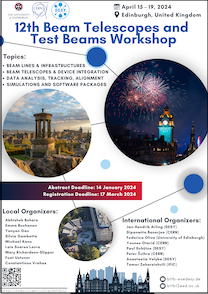Speaker
Description
Modern pixel detectors are being built to withstand the ever higher collision rates and pile-up of colliders designed to push luminosity and intensity limits. The ITk is a new silicon tracker for the ATLAS experiment designed to increase detector resolution, readout capacity, and radiation hardness, and the five innermost layers will be built of hybrid pixel modules. The material budget of the modules and support structures strongly influences the tracking and vertexing performance of the detector. During the R&D phase, the material budget of detector components is usually estimated from material content expectations for individual components, and is only verified after commissioning in dedicated runs of the detector.
We present a measurement of the radiation length of an ATLAS ITk pixel module performed at a testbeam at the CERN Proton Synchrotron using the multiple scattering of low-energy positrons within the module volume. Using a four-plane telescope of thin monolithic pixel detectors from the MALTA collaboration, scattering datasets were recorded at various beam energies and telescope configurations. Kink angle distributions are extracted from tracks derived both with and without information from the ITk pixel module. These are fit to extract the RMS scattering angle which can be converted to a fractional radiation length via the inverse highland formula, resulting in a 2D map of the module’s radiation length with O(10%) uncertainty and sub-mm resolution. Following a comparison of the results to empirical estimates, we explore the different beam energies, tracking configurations, and methodological choices made, to give a wider commentary on the potential and flexibility of the chosen method for material budget estimates of both position-sensitive and non-instrumented subjects.
